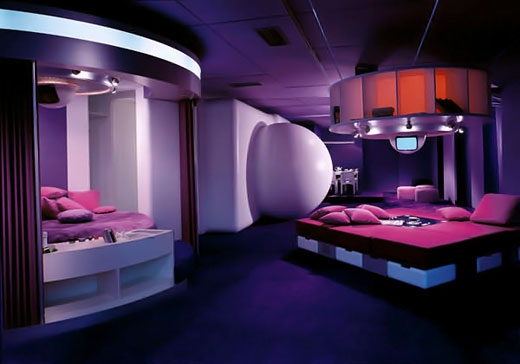This was the Future, Vol.12
typed for your pleasure on 3 June 2005, at 4.49 pmSdtrk: ‘The drowning man’ by the Cure
Another ABS-moulded spotlight on another ace designer; this time it’s Italian-born Joe Colombo.

his ‘Habitat of the Future’ for Visiona 69
Joe Colombo’s future was an anti-nostalgic future (he would not have recognised as “future” the ‘90s in which we live today), in which an intelligent technology would have helped every human activity, laying the foundations for completely new living models. At the time, Joe Colombo designed entire living cells.
quoted from this site
He’s one of my favourites, as he was all about the Modular Living. With regards to his design for appliances, furniture, and living areas, he constructed spaces and things that could be well used and conveniently stored. Where’s the saucepan? Where’s the crockery? Ahhh, it’s all nestled within each other in the Mini-kitchen’s crockery drawer. A Colombo design meant that it promoted more efficient living, yet it was fun at the same time. This is a man who engineered a small glass that could be held with your thumb, while you hang onto your cigarette with the fingers of that same hand. (He loved smoking.) That’s called Getting More Use Out Of A Single Hand!
And no, I’ve no idea what that giant white sphere in the picture is for exactly. In all the articles in print or online that I’ve read that cover the Visiona 69 environment, not a single one indicates what that sphere’s for. Perhaps it contains pure, unfiltered Sixties! I dunno
Random similar posts, for more timewasting:
This was the Future, Vol.30 on September 30th, 2006
This was the Future, Vol.21 on January 8th, 2006














June 4th, 2005 at 3.53 pm
I researched this one for you, Davecat. I’m now certain its an early Sunbeam brand bread machine.
This model (Bread-matic MkII, circa 1967) was designed for Sunbeam by a young engineer sniped from General Electric with promises of private parking spaces and a corporate car (specifically, a Chevrolet Corvair).
Anyway, had three kneading speeds, an early robotic elevator which carried kneaded dough to a miniature yeast rising chamber and, ultimately, an oven.
Located in the rear of the unit (blocked by the pillar in your picture) was a three-section door exposing dry goods storage and water supply.
Because it weighed approximately 2 tons, this unit was designed as a sphere so that it could be rolled easily from place to place.
Ultimately, its $6500 pricetag and extreme size limited the demand for this unit to a very small number of wealthy interior designers.
So there you have it!
June 5th, 2005 at 3.47 am
That’s some toaster!
June 6th, 2005 at 2.27 pm
*phshaw!* Toaster.
No, my friend, a bread machine.
To make toast with it would be like using a bazooka to kill a small weasel. Effective, but hardly efficient.